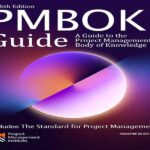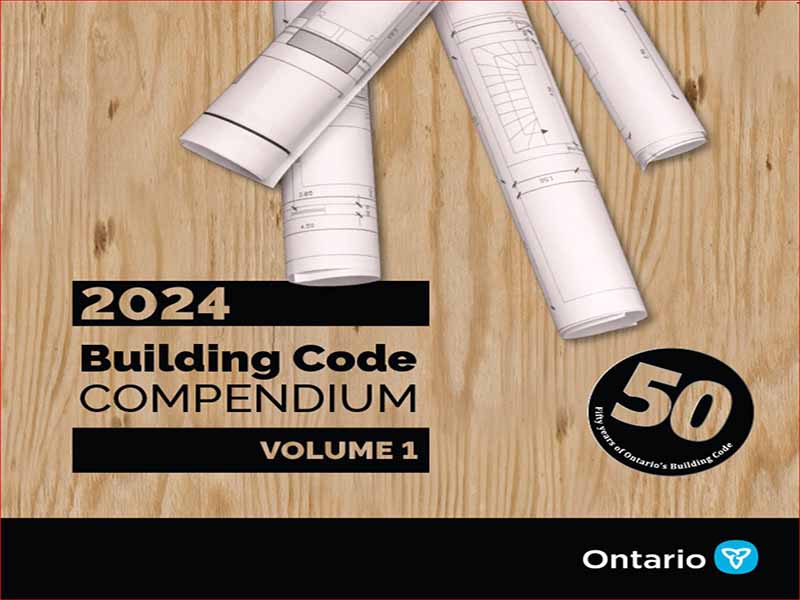- عنوان کتاب: Building Code Compendium Volume 1
- نویسنده: Ontario
- حوزه: ساخت و ساز
- سال انتشار: 2024
- تعداد صفحه: 1251
- زبان اصلی: انگلیسی
- نوع فایل: pdf
- حجم فایل: 15.7 مگابایت
کد ساختمان مقرراتی است که بر اساس قانون آیین نامه ساختمانی در سال 1992 تنظیم شده است. این ویرایش از مجموعه قوانین ساختمان، مقررات 203/24 انتاریو را در هم می آمیزد که آیین نامه ملی ساختمان 2020 را همراه با سند “اصلاحات انتاریو در کد ملی ساختمان کانادا 2020” تصویب می کند. “. این خلاصه همچنین حاوی استانداردهای تکمیلی است که توسط کد ساختمان به آنها ارجاع داده شده است و مطالب توضیحی اضافی در یادداشت های ضمیمه که فقط برای سهولت تهیه شده اند. قانون ساختمان 2024 از 1 ژانویه 2025 لازم الاجرا است. آیین نامه ساختمان الزامات فنی را برای ساخت و ساز (از جمله نوسازی) ساختمان ها، تغییر کاربری ساختمان های موجود که در آن تغییر منجر به افزایش خطر می شود و برای نگهداری و بهره برداری از ساختمان ها تعیین می کند. -سیستم های فاضلاب سایت الزامات فنی آیین نامه ساختمان برای ساختمان های موجود به جز تعمیر و نگهداری و بهره برداری از سیستم های فاضلاب در محل و ساختمان هایی که در معرض تغییر کاربری قرار می گیرند در جایی که تغییر منجر به افزایش خطر می شود، کاربرد ندارد. قانون ساختمان همچنین شامل الزامات اداری برای تخریب ساختمان است. آیین نامه ساختمان اساساً مجموعه ای از حداقل مقررات مربوط به ایمنی ساختمان ها با اشاره به بهداشت عمومی، حفاظت در برابر آتش، دسترسی، کفایت سازه، کارایی انرژی و یکپارچگی محیطی است. در نظر گرفته شده است که این کتاب درسی در مورد طراحی ساختمان نیست، که در مورد آن باید از منابع حرفه ای راهنمایی بگیرید. هدف اصلی آن ارتقای ایمنی عمومی از طریق اعمال استانداردهای یکنواخت ساختمانی مناسب است. کد ساختمان همچنین در قالبی مبتنی بر هدف نوشته شده است که هدف آن ارتقای نوآوری و انعطاف در طراحی و ساخت است. فرض بر این است که الزامات آیین نامه ساختمان توسط افراد معقول با استفاده از قضاوت خوب بر اساس تجربه و درک ایمنی و مسائل فنی مربوط تفسیر و اجرا می شود. این واقعیت به ویژه در کاربرد برای یک ساختمان موجود، زمانی که مالکان و مستاجران با موقعیتهایی مواجه میشوند که ممکن است به طور خاص در قوانین ساختمانی پوشش داده نشده باشند، یا در آن راهحلهای طراحی جایگزین پیشنهاد شدهاند که نمیتوانستند توسط کدنویسان و کدنویسان پیشبینی شده باشند، مهم است. کمیته های مسئول الزامات اولیه بسیاری از این قضاوت ها دشوار است زیرا اغلب دانش واقعی کافی برای معادل سازی ایمنی نسبی یک مجموعه از شرایط با مجموعه دیگر وجود ندارد. در ارزیابی هر پروژه بزرگ یا ساختمان غیرمعمول، موقعیتهایی پیش میآید که باید در آن قضاوت کرد، زیرا آییننامه هرگز نمیتواند همه موقعیتهای ممکن را پوشش دهد. آیین نامه ساختمان به طور مداوم در حال بررسی است و با توجه به کسب تجربه از استفاده از آن و کسب دانش اضافی از طریق تحقیق، تجدید نظر می شود. کد ساختمان، محصولات ساختمانی اختصاصی قابل قبول را فهرست نمی کند. معیارهایی را تعیین می کند که مصالح ساختمانی، محصولات، سیستم ها، طرح ها و مجموعه ها باید مطابقت داشته باشند. برخی از این معیارها به صراحت در قوانین ساختمان بیان شده است، در حالی که برخی دیگر با ارجاع به استانداردهای مواد یا محصول منتشر شده توسط سازمان های توسعه استاندارد گنجانده شده اند. فقط بخشهای فنی استانداردهای ارجاعشده که به اهداف و بیانیههای عملکردی آییننامه ساختمان مربوط میشوند، تنها در حدی اعمال میشوند که مقررات مربوط به ساخت و ساز ساختمانها باشد. مقررات آیین نامه ساختمان برای ویژگی های حفاظت در برابر آتش نصب شده در ساختمان ها به منظور ارائه حداقل سطح قابل قبول ایمنی عمومی در نظر گرفته شده است. در نظر گرفته شده است که تمام ویژگی های حفاظت در برابر آتش یک ساختمان، خواه مورد نیاز یا غیر ضروری باشد، مطابق با عملکرد مهندسی حفاظت از حریق خوب طراحی شده و الزامات نصب مناسب در استانداردهای مربوطه را برآورده کند. طراحی خوب لازم است تا اطمینان حاصل شود که سطح ایمنی عمومی تعیین شده توسط الزامات آیین نامه ساختمان با نصب داوطلبانه کاهش نمی یابد. به طور مشابه، برای نصب داوطلبانه سایر عناصر ساختمان مانند میلههای دستگیره یا حفاظها، انتظار عمومی وجود دارد که این تاسیسات عملکرد مورد نظر خود را برآورده کنند و با قوانین ساختمان مطابقت داشته باشند زیرا خرابی غیرمنتظره امنیت عمومی را به خطر میاندازد. آیین نامه ساختمان 2024 جایگزین نسخه قبلی آیین نامه ساختمانی 2012 می شود. بسیاری از تغییرات اعمال شده در آیین نامه ساختمانی 2024 سطح هماهنگی بین قوانین ساختمانی انتاریو و قوانین ساخت و ساز ملی و همچنین با سایر قوانین ساخت و ساز استانی و منطقه ای را افزایش می دهد.
The Building Code is a regulation made under the Building Code Act, 1992. This edition of the Building Code Compendium amalgamates Ontario Regulation 203/24 which adopts the 2020 National Building Code together with the document “Ontario Amendments to the National Building Code of Canada 2020”. This Compendium also contains the Supplementary Standards referenced by the Building Code and additional explanatory material in Appendix Notes which are prepared for purposes of convenience only. The 2024 Building Code is effective January 1, 2025. The Building Code sets out technical requirements for construction (including renovation) of buildings, change of use of existing buildings where the change would result in an increase in hazard and for maintenance and operation of on-site sewage systems. The technical requirements of the Building Code do not have application to existing buildings other than the maintenance and operation of on-site sewage systems and buildings that undergo a change of use where the change would result in an increase in hazard. The Building Code also contains administrative requirements for demolition of buildings. The Building Code is essentially a set of minimum provisions respecting the safety of buildings with reference to public health, fire protection, accessibility, structural sufficiency, energy efficiency and environmental integrity. It is not intended to be a textbook on building design, advice on which should be sought from professional sources. Its primary purpose is the promotion of public safety through the application of appropriate uniform building standards. The Building Code is also written in an objective-based format, which is intended to promote innovation and flexibility in design and construction. It is assumed that the requirements of the Building Code would be interpreted and enforced by reasonable people using good judgement based on experience and an understanding of the safety and technical issues involved. This fact is especially important in the application to an existing building when owners and tenants are faced with situations which may not be specifically covered in the Building Code, or in which alternative design solutions are proposed that could not have been envisaged by the code writers and committees responsible for the original requirements. Many of these judgments are difficult to make because there is often insufficient factual knowledge to equate the relative safety of one set of conditions to another set. In the evaluation of any major project or unusual building, situations arise in which judgments must be made, because the Code can never cover all possible situations. The Building Code is constantly under review and is revised as experience is gained from its use and additional knowledge is gained through research. The Building Code does not list acceptable proprietary building products. It establishes the criteria that building materials, products, systems, designs, and assemblies must meet. Some of these criteria are explicitly stated in the Building Code, while others are incorporated by reference to material or product standards published by standards development organizations. Only those technical portions of the referenced standards that are related to the objectives and functional statements of the Building Code apply only to the extent that the provisions relate to the construction of buildings. The provisions of the Building Code for fire protection features installed in buildings are intended to provide a minimum acceptable level of public safety. It is intended that all fire protection features of a building, whether required or not, would be designed in conformance with good fire protection engineering practice and would meet the appropriate installation requirements in relevant standards. Good design is necessary to ensure that the level of public safety established by the Building Code requirements would not be reduced by a voluntary installation. Similarly, for voluntary installations of other building elements such as grab bars or guards, there is a public expectation that these installations would meet their intended function and conform to the Building Code as unexpected failure would place public safety at risk. The 2024 Building Code supersedes the previous edition of the 2012 Building Code. Many of the changes introduced into the 2024 Building Code increase the level of harmonization between Ontario’s Building Code and the National Construction Codes as well as with other provincial and territorial construction codes.
این کتاب را میتوانید از لینک زیر بصورت رایگان دانلود کنید:
Download: Building Code Compendium Volume 1




































نظرات کاربران